Unit3How do you get to school.SectionB2a-SelfCheck课件2023-2024学年度人教版英语七年级下册
文档属性
| 名称 | Unit3How do you get to school.SectionB2a-SelfCheck课件2023-2024学年度人教版英语七年级下册 | 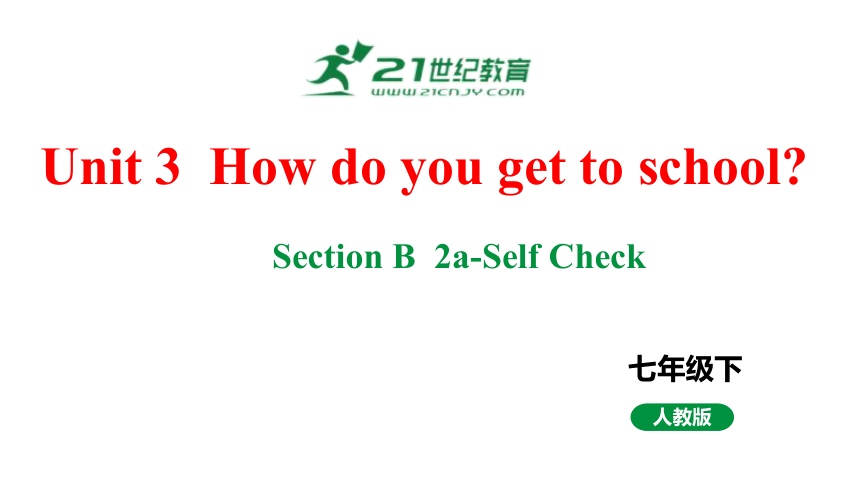 | |
| 格式 | pptx | ||
| 文件大小 | 62.2MB | ||
| 资源类型 | 试卷 | ||
| 版本资源 | 人教新目标(Go for it)版 | ||
| 科目 | 英语 | ||
| 更新时间 | 2024-02-22 08:45:25 | ||
图片预览

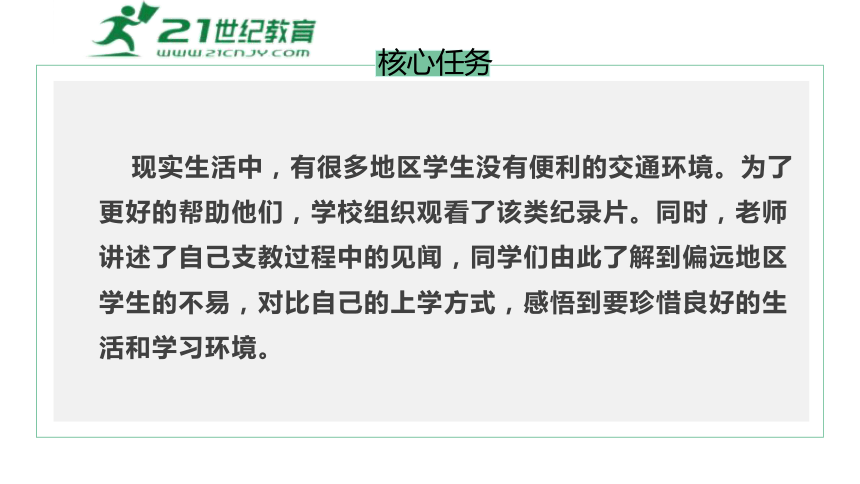
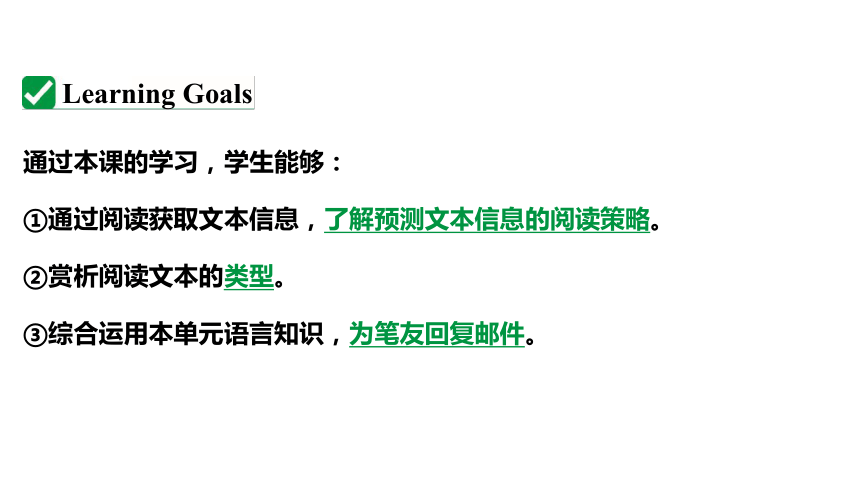

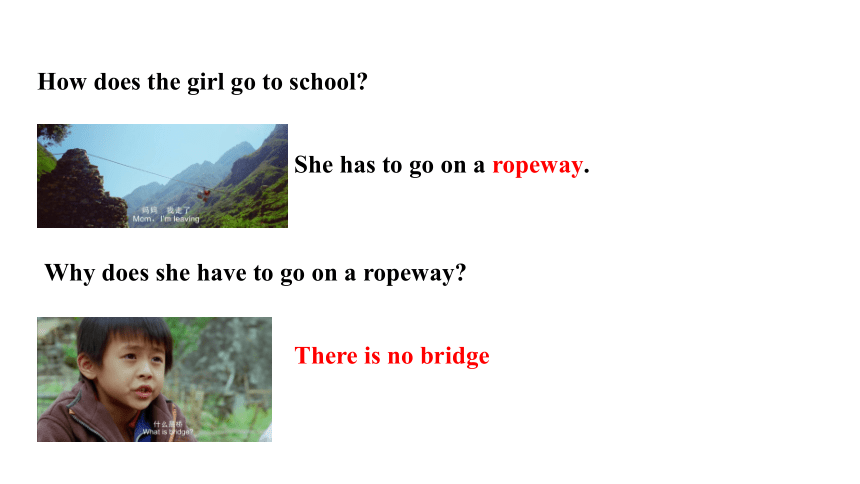
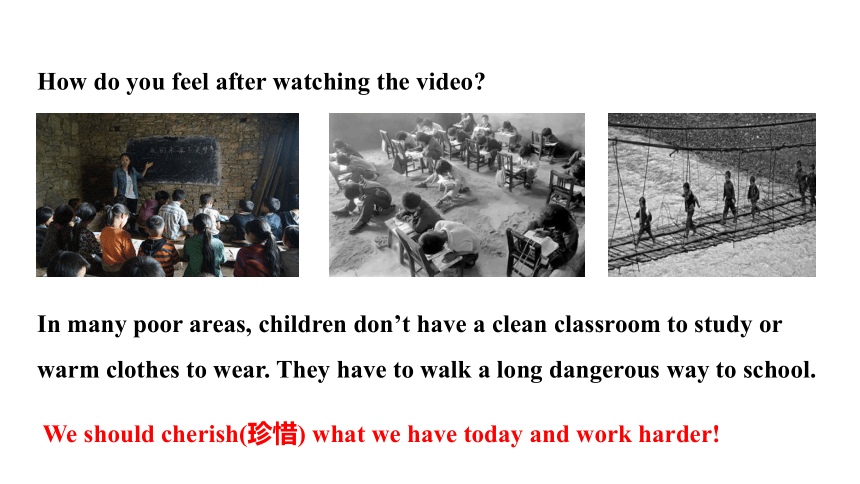
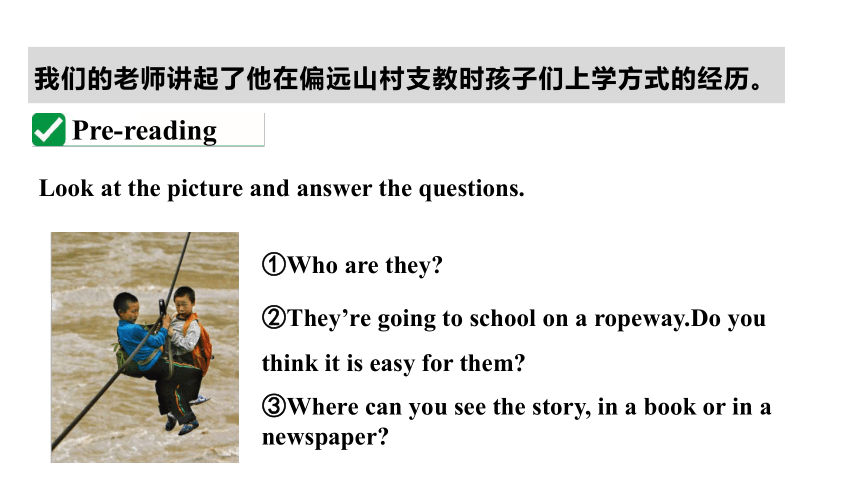
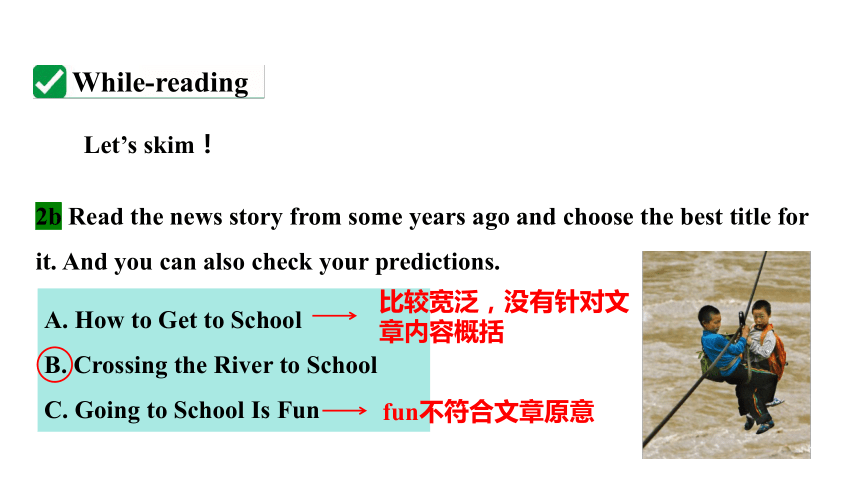
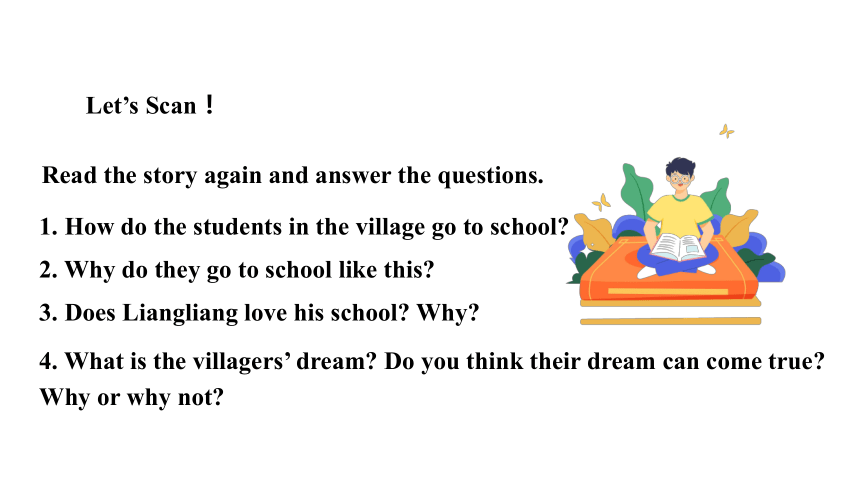
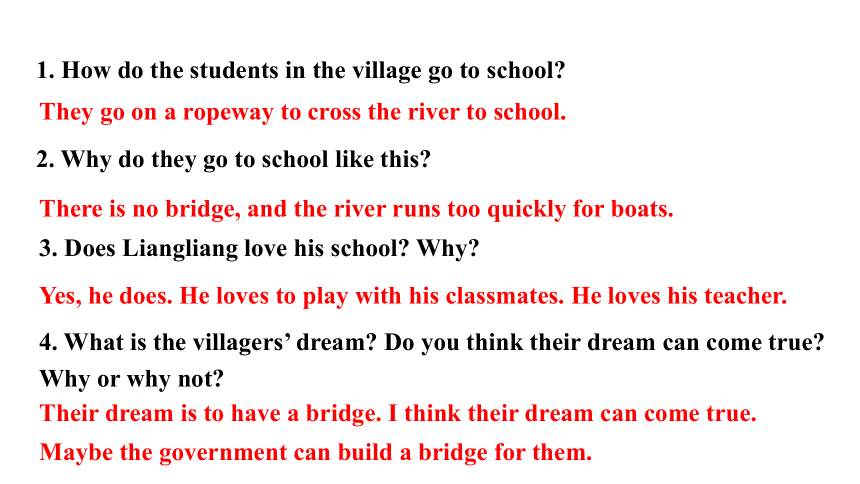
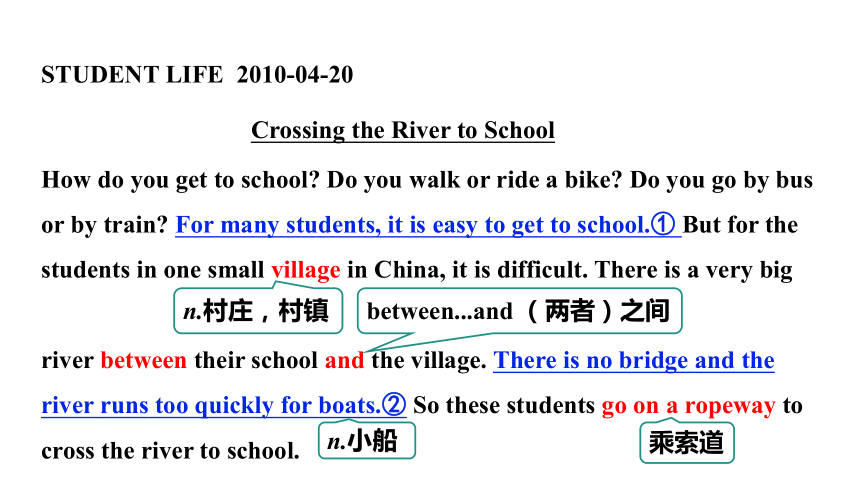
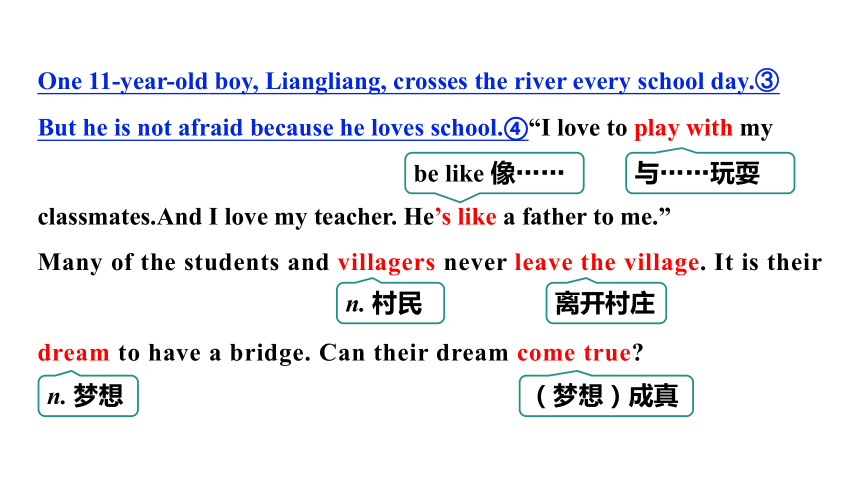
文档简介
(共43张PPT)
Unit 3 How do you get to school
Section B 2a-Self Check
七年级下
人教版
现实生活中,有很多地区学生没有便利的交通环境。为了更好的帮助他们,学校组织观看了该类纪录片。同时,老师讲述了自己支教过程中的见闻,同学们由此了解到偏远地区学生的不易,对比自己的上学方式,感悟到要珍惜良好的生活和学习环境。
核心任务
通过本课的学习,学生能够:
①通过阅读获取文本信息,了解预测文本信息的阅读策略。
②赏析阅读文本的类型。
③综合运用本单元语言知识,为笔友回复邮件。
Learning Goals
Let’s first watch a video and then tell how you feel after watching it.
Warming Up
How does the girl go to school
She has to go on a ropeway.
Why does she have to go on a ropeway
There is no bridge
How do you feel after watching the video
In many poor areas, children don’t have a clean classroom to study or
warm clothes to wear. They have to walk a long dangerous way to school.
We should cherish(珍惜) what we have today and work harder!
Look at the picture and answer the questions.
①Who are they
②They’re going to school on a ropeway.Do you think it is easy for them
③Where can you see the story, in a book or in a newspaper
Pre-reading
我们的老师讲起了他在偏远山村支教时孩子们上学方式的经历。
2b Read the news story from some years ago and choose the best title for it. And you can also check your predictions.
Let’s skim!
A. How to Get to School
B. Crossing the River to School
C. Going to School Is Fun
比较宽泛,没有针对文章内容概括
fun不符合文章原意
While-reading
Let’s Scan!
Read the story again and answer the questions.
1. How do the students in the village go to school
2. Why do they go to school like this
3. Does Liangliang love his school Why
4. What is the villagers’ dream Do you think their dream can come true Why or why not
1. How do the students in the village go to school
2. Why do they go to school like this
3. Does Liangliang love his school Why
4. What is the villagers’ dream Do you think their dream can come true Why or why not
They go on a ropeway to cross the river to school.
There is no bridge, and the river runs too quickly for boats.
Yes, he does. He loves to play with his classmates. He loves his teacher.
Their dream is to have a bridge. I think their dream can come true. Maybe the government can build a bridge for them.
STUDENT LIFE 2010-04-20
Crossing the River to School
How do you get to school Do you walk or ride a bike Do you go by bus or by train For many students, it is easy to get to school.① But for the students in one small village in China, it is difficult. There is a very big
river between their school and the village. There is no bridge and the river runs too quickly for boats.② So these students go on a ropeway to cross the river to school.
n.村庄,村镇
between...and (两者)之间
n.小船
乘索道
One 11-year-old boy, Liangliang, crosses the river every school day.③ But he is not afraid because he loves school.④“I love to play with my
classmates.And I love my teacher. He’s like a father to me.”
Many of the students and villagers never leave the village. It is their
dream to have a bridge. Can their dream come true
与……玩耍
be like 像……
n. 村民
离开村庄
n. 梦想
(梦想)成真
2c Read the story again and complete the interview.
Reporter: How do you _____to school, Liangliang
Liangliang: I go on a ropeway to ______ the river to school.
Reporter: Are you ________
Liangliang: No, I’m not. Because I_____ my school and my teachers. I like to________ with my classmates at school.
Reporter: Is it __________ for you to go to school
go
cross
afraid
love
play
difficult
了解到孩子们的困境后,一位记者来到了当地采访。
Liangliang: Yes, it is.
Reporter: Do you want to have a _________
Liangliang: Yes. It’s our dream.
Reporter: I’m sure your dream can come ________.
bridge
true
Now, work in pairs to role play the interview out.
2d Now there is a bridge across the river and the children do not have to go on the ropeway to get to school anymore. Imagine you are a reporter and want to interview a student in the school. Make up a conversation.
Post-reading
在看到这位记者的采访后,政府迅速组织专家,为孩子们建造了“上学桥”。
1. Topic
Today we are going to learn how to write an e-mail to Tom and tell him how you get to school.
Pre-writing
在看到这些孩子们的上学之路后,我异常珍惜我的生活和学习条件。Tom写信询问我是如何上学的,我正在给他回信。
2. Structure
3a Read the e-mail from your pen pal Tom in the US. Fill in the blanks with the words in the box.
kilometers get to takes walk boring leave
Hi there,
How are you Thanks for your last e-mail. You want to know how I ______school, right Well, I usually _______ my home at about 8:00 and ______ to the bus stop. The school bus usually comes at about 8:15. My school is about 20 ___________ from my home.
get to
leave
walk
kilometers
kilometers get to takes walk boring leave
It ______ about 40 minutes to get there by bus. The bus ride is never _______ because I always talk to my classmates.
What about you How do you get to school
Tom
takes
boring
Hi there,
How are you Thanks for your last e-mail. You want to know how I get to school, right Well, I usually leave my home at about 8:00 and walk to the bus stop. The school bus usually comes at about 8:15. My school is about 20 kilometers from my home. It takes about 40 minutes to get there by bus. The bus ride is never boring because I always talk to my classmates.
What about you How do you get to school
Tom
邮件左上角打招呼,注意逗号
开头问候,交代邮件内容
正文详细介绍时间、方式、距离
可发表自己的感受
结尾询问对方
左下角署名
注意若在左下角署名,正文所有段落需顶格
3. Words and Expressions
1. When do you leave home
2. How do you get to school
3. How far is it from your home to school
4. How long does it take you to get to school
5. Do you like your trip to school
Answer the following questions and write your answers down.
3b Write an e-mail to Tom and tell him how you get to school.
While-writing
Now, you can share your e-mail with your partners and then I’ll invite some of you to share with the whole class.
Post-writing
1 Use the words in the boxes to form as many expressions as possible.
take, walk, ride, drive
bus, train, car, bike, plane, subway, boat
by
take
walk
ride
drive
by
bus, train, plane, bike, subway, boat, car
a/the bus, a/the train, a/the plane, the subway, a/the boat
a bike
a/the car, a/the bus, a/the train
尽可能多的表达;as...as possible 尽可能……
Self-Check
2 Look at the chart below. Write at least five questions. Then answer the questions with the information in the chart.
Who Where How How far How long
Tony from home to school by bike 5 km 20 minutes
Mary from home to the library by bus 15 km 40 minutes
How does Tony get to school He gets to school by bike.
Questions Answers
1. How does Tony get to school He gets to school by bike.
2. How does Mary get to the library from home
3. How far is it from Tony’s home to school
4. How far is it from Mary’s home to the library
She gets to the library by bus.
It is 5 kilometers.
It is 15 kilometers.
6. How long does it take Mary to get to the library by bus
5. How long does it take Tony to get to school by bike
It takes 40 minutes.
It takes 20 minutes.
对某人来说做某事是…… 的 ______________________
(两者)之间 ______________________
根本没有桥。 ______________________
乘索道 ______________________
11岁的 ____________________________
It is + adj. + for/of sb. +to do sth.
between...and
There is no bridge.
go on a ropeway
11-year-old
Key Phrases
leave the village
come true
害怕(做)某事/害怕做 ______________________
与……玩耍 ______________________
像…… ______________________
离开村庄 ______________________
梦想成真 ______________________
be afraid of (doing) sth. /be afraid to do sth.
play with…
be like…
1.For many students, it is easy to get to school.
①It is + adj. + (for sb.) +to do sth. 对某人来说做某事是……的。
其中it为形式主语,真正的主语为后面的to do不定式 ;adj. 用来修饰后面的事情。
②It is + adj. + (of sb.) +to do sth. 对某人来说做某事是……的。
adj. 用来修饰人,如 kind, clever, nice 等。
It is kind of you to help me.
Language Points
Instant Training
1. 要小孩回答这个问题是很困难的。____________________________________________________.
2. 她的确很聪明,能把这件事做得这么好。
____________________________________________________ .
3. 结识来自这个国家不同地区的人是有益的。
____________________________________________________ .
It's hard for difficult for children to answer this question
It's clever of her to do it so well
It's good to meet people from different parts of the country
选择适当句型,翻译下列句子:
①It is + adj. + (for sb.) +to do sth.
②It is + adj. + (of sb.) +to do sth.
2.There is no bridge and the river runs too quickly for boats.
There is not a bridge ... 和There is no bridge
以上两个句子都表示 “没有桥”,但在语气上后者比前者要强。因此,There’s no bridge …更加接近中文的 “根本没有桥”的意思。
I’m not a doctor. 我不是大夫。
I’m no doctor: 我压根就不是个大夫。(我根本不懂医。)
若no用于复数,则相当于 not any。
There are no buses on Sundays. (= There aren’t any buses on Sundays.)
the river runs too quickly 河水流的太急了
run 在此处语境中表示液体的“流动”
The tears ran down her cheeks.
泪水顺着她的脸淌下来。
Water was running all over the bathroom floor.
浴室里水流满地。
Instant Training
1. 他不可能改变主意。
____________________that he will change his mind.
2. 你明天不必早起。
_________________ for you to get up early tomorrow.
3.法网恢恢,疏而不漏。
__________________from the long arm of the law.
There is no chance
There is no need
There is no escape
3.One 11-year-old boy, Liangliang, crosses the river every school day.
①11-year-old是复合形容词,作前置定语修饰名词boy,需注意 year 应用单数形式,中间以连字符连接;11的发音以元音音素开头,其前若有不定冠词,应用 an。
Jane is an 5-year-old girl.
简是一个5岁的女孩。
Nora thought Tom was seven years old.
诺拉觉得汤姆有7岁。
拓展:year-old与years old的区别
year-old是“xx岁的”的意思,是形容词,一般用作定语,修饰名词,也可以用作名词。
years old,是个形容词短语,可做谓语,不可以做冠词,即不可以用来修饰名词代词等。
②cross在此处相当于 go across,指从物体表面穿过、横过。
I cross the railway bridge every day on my way to school.
我每天上学路上要穿越铁路桥。
Instant Training
1. 请把卡片送给我5岁的儿子。
Please give cards to my ____________ son.
2. 让我们系好安全带,绕全国走一遭。
Let's buckle up and ___________country.
3.俱乐部里的人个个看起来都像14岁的模样。
Everybody in the club looked to be ________________.
5-year-old
go cross
fourteen years old
4.But he is not afraid because he loves school.
afraid adj. 害怕的
be afraid of (doing) sth. 害怕(做)某事
be afraid to do sth. 害怕做
Don’t be afraid to ask if you don’t understand.
你要是不懂,尽管问好了。
I’m afraid of going out alone at night.
我害怕夜间单独外出。
Instant Training
1. Jenny ______travel by plane. She feels nervous(紧张) when she flies.
A. afraid to B. is afraid to C. is afraid D. afraid of
2.我害怕与陌生人说话。(陌生人:n. stranger, pl. strangers)
________________________________________________________
3.不要害怕困难。
________________________________________________________
B
I'm afraid of talking to strangers.
Don’t be afraid of difficulties.
1. There are no _______ (bridge) over the river.
2. The students _______ (cross) the river to school every day.
3. Many students and _______ (village) never leave the village.
4. It’s their dream _______ (have) a bridge.
5. He is ninety _______ (year) old.
bridges
cross
villagers
to have
years
Exercises
给Tom讲述记录片中学生艰难上学的情况。
1.It’s sad _______ me _______ their story.
A.for; know B.of; know C.for; to know D.of; to know
2.I could easily get back home from school. It _______ me about two hours to do my homework.
A.takes B.makes C.needs D.asks
3.I have a _______ sister.
A.six-year old B.six-years old
C.six-year-old D.six years old
A
C
C
我对现有的生活学习条件倍感珍惜。
4.We don’t use dangerous tools(危险工具)_______ ropes and buckles(搭扣).
A. about B. with C.like D. for
5.What do you _______ their (经历) We should cherish(珍惜) our living and study conditions.
A.come on B.think of C.talk to D.play with
C
B
写到这里,我询问Tom会有怎样的感受。
1.Passage: crossing the river to school
2.Words and Expressions:
cross, river, many, village, between, bridge, boat, ropeway, year, afraid,
like, villager, leave, dream, true, between... and..., come true
3.Key sentences:
①There is a very big river between their school and the village.
②But he is not afraid because he loves school.
4.Writing: Write an e-mail talking about how you get to school.
Summary
Crossing the River to School
Why
What
How
Who
Dream
the students in one small village
big river
no bridge
ropeway
11 years old
every school day
classmates
teacher
difficult to get to school
no boats
Liangliang
have a bridge
Take some books or clothes you don’t need any more to school.
We’ll donate(捐赠) them to poor areas.
实践与拓展
Unit 3 How do you get to school
Section B 2a-Self Check
七年级下
人教版
现实生活中,有很多地区学生没有便利的交通环境。为了更好的帮助他们,学校组织观看了该类纪录片。同时,老师讲述了自己支教过程中的见闻,同学们由此了解到偏远地区学生的不易,对比自己的上学方式,感悟到要珍惜良好的生活和学习环境。
核心任务
通过本课的学习,学生能够:
①通过阅读获取文本信息,了解预测文本信息的阅读策略。
②赏析阅读文本的类型。
③综合运用本单元语言知识,为笔友回复邮件。
Learning Goals
Let’s first watch a video and then tell how you feel after watching it.
Warming Up
How does the girl go to school
She has to go on a ropeway.
Why does she have to go on a ropeway
There is no bridge
How do you feel after watching the video
In many poor areas, children don’t have a clean classroom to study or
warm clothes to wear. They have to walk a long dangerous way to school.
We should cherish(珍惜) what we have today and work harder!
Look at the picture and answer the questions.
①Who are they
②They’re going to school on a ropeway.Do you think it is easy for them
③Where can you see the story, in a book or in a newspaper
Pre-reading
我们的老师讲起了他在偏远山村支教时孩子们上学方式的经历。
2b Read the news story from some years ago and choose the best title for it. And you can also check your predictions.
Let’s skim!
A. How to Get to School
B. Crossing the River to School
C. Going to School Is Fun
比较宽泛,没有针对文章内容概括
fun不符合文章原意
While-reading
Let’s Scan!
Read the story again and answer the questions.
1. How do the students in the village go to school
2. Why do they go to school like this
3. Does Liangliang love his school Why
4. What is the villagers’ dream Do you think their dream can come true Why or why not
1. How do the students in the village go to school
2. Why do they go to school like this
3. Does Liangliang love his school Why
4. What is the villagers’ dream Do you think their dream can come true Why or why not
They go on a ropeway to cross the river to school.
There is no bridge, and the river runs too quickly for boats.
Yes, he does. He loves to play with his classmates. He loves his teacher.
Their dream is to have a bridge. I think their dream can come true. Maybe the government can build a bridge for them.
STUDENT LIFE 2010-04-20
Crossing the River to School
How do you get to school Do you walk or ride a bike Do you go by bus or by train For many students, it is easy to get to school.① But for the students in one small village in China, it is difficult. There is a very big
river between their school and the village. There is no bridge and the river runs too quickly for boats.② So these students go on a ropeway to cross the river to school.
n.村庄,村镇
between...and (两者)之间
n.小船
乘索道
One 11-year-old boy, Liangliang, crosses the river every school day.③ But he is not afraid because he loves school.④“I love to play with my
classmates.And I love my teacher. He’s like a father to me.”
Many of the students and villagers never leave the village. It is their
dream to have a bridge. Can their dream come true
与……玩耍
be like 像……
n. 村民
离开村庄
n. 梦想
(梦想)成真
2c Read the story again and complete the interview.
Reporter: How do you _____to school, Liangliang
Liangliang: I go on a ropeway to ______ the river to school.
Reporter: Are you ________
Liangliang: No, I’m not. Because I_____ my school and my teachers. I like to________ with my classmates at school.
Reporter: Is it __________ for you to go to school
go
cross
afraid
love
play
difficult
了解到孩子们的困境后,一位记者来到了当地采访。
Liangliang: Yes, it is.
Reporter: Do you want to have a _________
Liangliang: Yes. It’s our dream.
Reporter: I’m sure your dream can come ________.
bridge
true
Now, work in pairs to role play the interview out.
2d Now there is a bridge across the river and the children do not have to go on the ropeway to get to school anymore. Imagine you are a reporter and want to interview a student in the school. Make up a conversation.
Post-reading
在看到这位记者的采访后,政府迅速组织专家,为孩子们建造了“上学桥”。
1. Topic
Today we are going to learn how to write an e-mail to Tom and tell him how you get to school.
Pre-writing
在看到这些孩子们的上学之路后,我异常珍惜我的生活和学习条件。Tom写信询问我是如何上学的,我正在给他回信。
2. Structure
3a Read the e-mail from your pen pal Tom in the US. Fill in the blanks with the words in the box.
kilometers get to takes walk boring leave
Hi there,
How are you Thanks for your last e-mail. You want to know how I ______school, right Well, I usually _______ my home at about 8:00 and ______ to the bus stop. The school bus usually comes at about 8:15. My school is about 20 ___________ from my home.
get to
leave
walk
kilometers
kilometers get to takes walk boring leave
It ______ about 40 minutes to get there by bus. The bus ride is never _______ because I always talk to my classmates.
What about you How do you get to school
Tom
takes
boring
Hi there,
How are you Thanks for your last e-mail. You want to know how I get to school, right Well, I usually leave my home at about 8:00 and walk to the bus stop. The school bus usually comes at about 8:15. My school is about 20 kilometers from my home. It takes about 40 minutes to get there by bus. The bus ride is never boring because I always talk to my classmates.
What about you How do you get to school
Tom
邮件左上角打招呼,注意逗号
开头问候,交代邮件内容
正文详细介绍时间、方式、距离
可发表自己的感受
结尾询问对方
左下角署名
注意若在左下角署名,正文所有段落需顶格
3. Words and Expressions
1. When do you leave home
2. How do you get to school
3. How far is it from your home to school
4. How long does it take you to get to school
5. Do you like your trip to school
Answer the following questions and write your answers down.
3b Write an e-mail to Tom and tell him how you get to school.
While-writing
Now, you can share your e-mail with your partners and then I’ll invite some of you to share with the whole class.
Post-writing
1 Use the words in the boxes to form as many expressions as possible.
take, walk, ride, drive
bus, train, car, bike, plane, subway, boat
by
take
walk
ride
drive
by
bus, train, plane, bike, subway, boat, car
a/the bus, a/the train, a/the plane, the subway, a/the boat
a bike
a/the car, a/the bus, a/the train
尽可能多的表达;as...as possible 尽可能……
Self-Check
2 Look at the chart below. Write at least five questions. Then answer the questions with the information in the chart.
Who Where How How far How long
Tony from home to school by bike 5 km 20 minutes
Mary from home to the library by bus 15 km 40 minutes
How does Tony get to school He gets to school by bike.
Questions Answers
1. How does Tony get to school He gets to school by bike.
2. How does Mary get to the library from home
3. How far is it from Tony’s home to school
4. How far is it from Mary’s home to the library
She gets to the library by bus.
It is 5 kilometers.
It is 15 kilometers.
6. How long does it take Mary to get to the library by bus
5. How long does it take Tony to get to school by bike
It takes 40 minutes.
It takes 20 minutes.
对某人来说做某事是…… 的 ______________________
(两者)之间 ______________________
根本没有桥。 ______________________
乘索道 ______________________
11岁的 ____________________________
It is + adj. + for/of sb. +to do sth.
between...and
There is no bridge.
go on a ropeway
11-year-old
Key Phrases
leave the village
come true
害怕(做)某事/害怕做 ______________________
与……玩耍 ______________________
像…… ______________________
离开村庄 ______________________
梦想成真 ______________________
be afraid of (doing) sth. /be afraid to do sth.
play with…
be like…
1.For many students, it is easy to get to school.
①It is + adj. + (for sb.) +to do sth. 对某人来说做某事是……的。
其中it为形式主语,真正的主语为后面的to do不定式 ;adj. 用来修饰后面的事情。
②It is + adj. + (of sb.) +to do sth. 对某人来说做某事是……的。
adj. 用来修饰人,如 kind, clever, nice 等。
It is kind of you to help me.
Language Points
Instant Training
1. 要小孩回答这个问题是很困难的。____________________________________________________.
2. 她的确很聪明,能把这件事做得这么好。
____________________________________________________ .
3. 结识来自这个国家不同地区的人是有益的。
____________________________________________________ .
It's hard for difficult for children to answer this question
It's clever of her to do it so well
It's good to meet people from different parts of the country
选择适当句型,翻译下列句子:
①It is + adj. + (for sb.) +to do sth.
②It is + adj. + (of sb.) +to do sth.
2.There is no bridge and the river runs too quickly for boats.
There is not a bridge ... 和There is no bridge
以上两个句子都表示 “没有桥”,但在语气上后者比前者要强。因此,There’s no bridge …更加接近中文的 “根本没有桥”的意思。
I’m not a doctor. 我不是大夫。
I’m no doctor: 我压根就不是个大夫。(我根本不懂医。)
若no用于复数,则相当于 not any。
There are no buses on Sundays. (= There aren’t any buses on Sundays.)
the river runs too quickly 河水流的太急了
run 在此处语境中表示液体的“流动”
The tears ran down her cheeks.
泪水顺着她的脸淌下来。
Water was running all over the bathroom floor.
浴室里水流满地。
Instant Training
1. 他不可能改变主意。
____________________that he will change his mind.
2. 你明天不必早起。
_________________ for you to get up early tomorrow.
3.法网恢恢,疏而不漏。
__________________from the long arm of the law.
There is no chance
There is no need
There is no escape
3.One 11-year-old boy, Liangliang, crosses the river every school day.
①11-year-old是复合形容词,作前置定语修饰名词boy,需注意 year 应用单数形式,中间以连字符连接;11的发音以元音音素开头,其前若有不定冠词,应用 an。
Jane is an 5-year-old girl.
简是一个5岁的女孩。
Nora thought Tom was seven years old.
诺拉觉得汤姆有7岁。
拓展:year-old与years old的区别
year-old是“xx岁的”的意思,是形容词,一般用作定语,修饰名词,也可以用作名词。
years old,是个形容词短语,可做谓语,不可以做冠词,即不可以用来修饰名词代词等。
②cross在此处相当于 go across,指从物体表面穿过、横过。
I cross the railway bridge every day on my way to school.
我每天上学路上要穿越铁路桥。
Instant Training
1. 请把卡片送给我5岁的儿子。
Please give cards to my ____________ son.
2. 让我们系好安全带,绕全国走一遭。
Let's buckle up and ___________country.
3.俱乐部里的人个个看起来都像14岁的模样。
Everybody in the club looked to be ________________.
5-year-old
go cross
fourteen years old
4.But he is not afraid because he loves school.
afraid adj. 害怕的
be afraid of (doing) sth. 害怕(做)某事
be afraid to do sth. 害怕做
Don’t be afraid to ask if you don’t understand.
你要是不懂,尽管问好了。
I’m afraid of going out alone at night.
我害怕夜间单独外出。
Instant Training
1. Jenny ______travel by plane. She feels nervous(紧张) when she flies.
A. afraid to B. is afraid to C. is afraid D. afraid of
2.我害怕与陌生人说话。(陌生人:n. stranger, pl. strangers)
________________________________________________________
3.不要害怕困难。
________________________________________________________
B
I'm afraid of talking to strangers.
Don’t be afraid of difficulties.
1. There are no _______ (bridge) over the river.
2. The students _______ (cross) the river to school every day.
3. Many students and _______ (village) never leave the village.
4. It’s their dream _______ (have) a bridge.
5. He is ninety _______ (year) old.
bridges
cross
villagers
to have
years
Exercises
给Tom讲述记录片中学生艰难上学的情况。
1.It’s sad _______ me _______ their story.
A.for; know B.of; know C.for; to know D.of; to know
2.I could easily get back home from school. It _______ me about two hours to do my homework.
A.takes B.makes C.needs D.asks
3.I have a _______ sister.
A.six-year old B.six-years old
C.six-year-old D.six years old
A
C
C
我对现有的生活学习条件倍感珍惜。
4.We don’t use dangerous tools(危险工具)_______ ropes and buckles(搭扣).
A. about B. with C.like D. for
5.What do you _______ their (经历) We should cherish(珍惜) our living and study conditions.
A.come on B.think of C.talk to D.play with
C
B
写到这里,我询问Tom会有怎样的感受。
1.Passage: crossing the river to school
2.Words and Expressions:
cross, river, many, village, between, bridge, boat, ropeway, year, afraid,
like, villager, leave, dream, true, between... and..., come true
3.Key sentences:
①There is a very big river between their school and the village.
②But he is not afraid because he loves school.
4.Writing: Write an e-mail talking about how you get to school.
Summary
Crossing the River to School
Why
What
How
Who
Dream
the students in one small village
big river
no bridge
ropeway
11 years old
every school day
classmates
teacher
difficult to get to school
no boats
Liangliang
have a bridge
Take some books or clothes you don’t need any more to school.
We’ll donate(捐赠) them to poor areas.
实践与拓展
同课章节目录
- Unit 1 Can you play the guitar?
- Section A
- Section B
- Unit 2 What time do you go to school?
- Section A
- Section B
- Unit 3 How do you get to school?
- Section A
- Section B
- Unit 4 Don't eat in class.
- Section A
- Section B
- Unit 5 Why do you like pandas?
- Section A
- Section B
- Unit 6 I'm watching TV.
- Section A
- Section B
- Review of Units 1-6
- Unit 7 It's raining!
- Section A
- Section B
- Unit 8 Is there a post office near here?
- Section A
- Section B
- Unit 9 What does he look like?
- Section A
- Section B
- Unit 10 I'd like some noodles.
- Section A
- Section B
- Unit 11 How was your school trip?
- Section A
- Section B
- Unit 12 What did you do last weekend?
- Section A
- Section B
